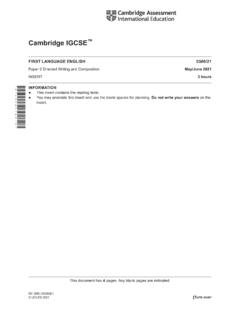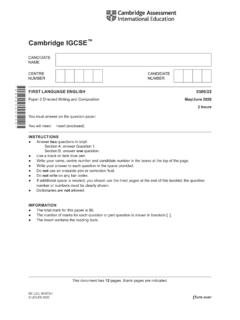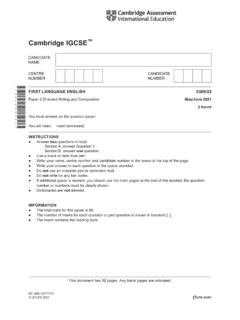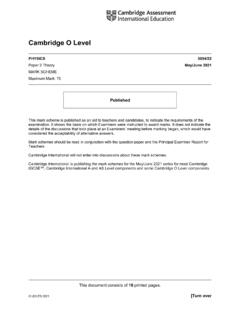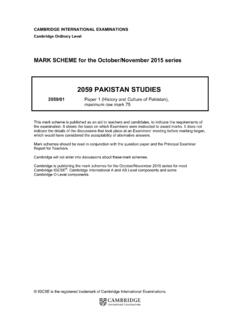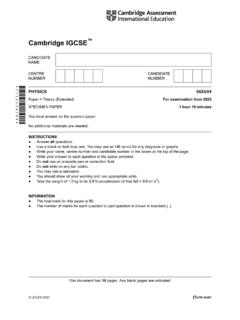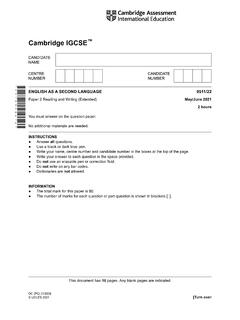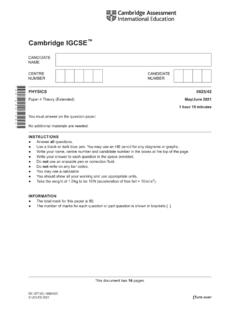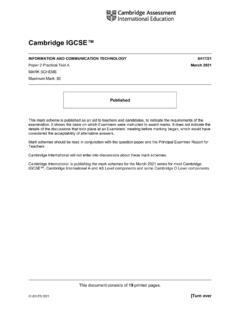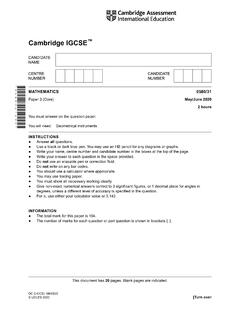Transcription of 0450 s21 ms 11
1 This document consists of 21 printed pages. UCLES 2021 [Turn over Cambridge IGCSE BUSINESS STUDIES 0450/11 Paper 1 Short Answer/Structured Response May/June 2021 MARK SCHEME Maximum Mark: 80 Published This mark scheme is published as an aid to teachers and candidates, to indicate the requirements of the examination. It shows the basis on which Examiners were instructed to award marks. It does not indicate the details of the discussions that took place at an Examiners meeting before marking began, which would have considered the acceptability of alternative answers . Mark schemes should be read in conjunction with the question paper and the Principal Examiner Report for Teachers. Cambridge International will not enter into discussions about these mark schemes.]
2 Cambridge International is publishing the mark schemes for the May/June 2021 series for most Cambridge IGCSE , Cambridge International A and AS Level components and some Cambridge O Level components. 0450/11 Cambridge IGCSE Mark Scheme PUBLISHED May/June 2021 UCLES 2021 Page 2 of 21 Generic Marking Principles These general marking principles must be applied by all examiners when marking candidate answers . They should be applied alongside the specific content of the mark scheme or generic level descriptors for a question. Each question paper and mark scheme will also comply with these marking principles. GENERIC MARKING PRINCIPLE 1: Marks must be awarded in line with: the specific content of the mark scheme or the generic level descriptors for the question the specific skills defined in the mark scheme or in the generic level descriptors for the question the standard of response required by a candidate as exemplified by the standardisation scripts.
3 GENERIC MARKING PRINCIPLE 2: Marks awarded are always whole marks (not half marks, or other fractions). GENERIC MARKING PRINCIPLE 3: Marks must be awarded positively: marks are awarded for correct/valid answers , as defined in the mark scheme. However, credit is given for valid answers which go beyond the scope of the syllabus and mark scheme, referring to your Team Leader as appropriate marks are awarded when candidates clearly demonstrate what they know and can do marks are not deducted for errors marks are not deducted for omissions answers should only be judged on the quality of spelling, punctuation and grammar when these features are specifically assessed by the question as indicated by the mark scheme. The meaning, however, should be unambiguous. GENERIC MARKING PRINCIPLE 4: Rules must be applied consistently, in situations where candidates have not followed instructions or in the application of generic level descriptors.
4 0450/11 Cambridge IGCSE Mark Scheme PUBLISHED May/June 2021 UCLES 2021 Page 3 of 21 GENERIC MARKING PRINCIPLE 5: Marks should be awarded using the full range of marks defined in the mark scheme for the question (however; the use of the full mark range may be limited according to the quality of the candidate responses seen). GENERIC MARKING PRINCIPLE 6: Marks awarded are based solely on the requirements as defined in the mark scheme. Marks should not be awarded with grade thresholds or grade descriptors in mind. 0450/11 Cambridge IGCSE Mark Scheme PUBLISHED May/June 2021 UCLES 2021 Page 4 of 21 Social Science-Specific Marking Principles (for point-based marking) 1 Components using point-based marking: Point marking is often used to reward knowledge, understanding and application of skills.
5 We give credit where the candidate s answer shows relevant knowledge, understanding and application of skills in answering the question. We do not give credit where the answer shows confusion. From this it follows that we: a DO credit answers which are worded differently from the mark scheme if they clearly convey the same meaning (unless the mark scheme requires a specific term) b DO credit alternative answers /examples which are not written in the mark scheme if they are correct c DO credit answers where candidates give more than one correct answer in one prompt/numbered/scaffolded space where extended writing is required rather than list-type answers . For example, questions that require n reasons ( State two reasons). d DO NOT credit answers simply for using a key term unless that is all that is required.
6 (Check for evidence it is understood and not used wrongly.) e DO NOT credit answers which are obviously self-contradicting or trying to cover all possibilities f DO NOT give further credit for what is effectively repetition of a correct point already credited unless the language itself is being tested. This applies equally to mirror statements ( polluted/not polluted). g DO NOT require spellings to be correct, unless this is part of the test. However spellings of syllabus terms must allow for clear and unambiguous separation from other syllabus terms with which they may be confused ( Corrasion/Corrosion) 2 Presentation of mark scheme: Slashes (/) or the word or separate alternative ways of making the same point. Semi colons (;) bullet points ( ) or figures in brackets (1) separate different points.
7 Content in the answer column in brackets is for examiner information/context to clarify the marking but is not required to earn the mark (except Accounting syllabuses where they indicate negative numbers). 0450/11 Cambridge IGCSE Mark Scheme PUBLISHED May/June 2021 UCLES 2021 Page 5 of 21 3 Calculation questions: The mark scheme will show the steps in the most likely correct method(s), the mark for each step, the correct answer(s) and the mark for each answer If working/explanation is considered essential for full credit, this will be indicated in the question paper and in the mark scheme. In all other instances, the correct answer to a calculation should be given full credit, even if no supporting working is shown. Where the candidate uses a valid method which is not covered by the mark scheme, award equivalent marks for reaching equivalent stages.
8 Where an answer makes use of a candidate s own incorrect figure from previous working, the own figure rule applies: full marks will be given if a correct and complete method is used. Further guidance will be included in the mark scheme where necessary and any exceptions to this general principle will be noted. 4 Annotation: For point marking, ticks can be used to indicate correct answers and crosses can be used to indicate wrong answers . There is no direct relationship between ticks and marks. Ticks have no defined meaning for levels of response marking. For levels of response marking, the level awarded should be annotated on the script. Other annotations will be used by examiners as agreed during standardisation, and the meaning will be understood by all examiners who marked that paper.
9 0450/11 Cambridge IGCSE Mark Scheme PUBLISHED May/June 2021 UCLES 2021 Page 6 of 21 Question Answer Marks Notes 1(a) Define public sector . Award 2 marks for a full definition. Award 1 mark for a partial definition. Government or state-owned businesses/organisations [2] OR Part of the economy controlled by state/government [2] Partial definition not owned by individuals [1] OR Provided/run by government [1] 2 1(b) Define profit Award 2 marks for a full definition. Award 1 mark for a partial definition. Amount of money left after all costs have been subtracted from revenue. [2] OR Surplus after total costs deducted from sales revenue [2] OR (Total) revenue total cost [2] OR Gross profit minus expenses [2] Partial definition revenue minus costs [1] 2 Do not credit answers such as money made by business.
10 [TV] 0450/11 Cambridge IGCSE Mark Scheme PUBLISHED May/June 2021 UCLES 2021 Page 7 of 21 Question Answer Marks Notes 1(c) Identify four ways to measure the size of a business Award 1 mark per way. Points could include: Sales value / value of output / revenue Volume of output / amount of services / amount of sales / number of customers (Value of) capital employed / value of statement of financial position / market capitalisation Market share Number of employees Number of outlets Other appropriate responses should also be credited. 4 Only award the first four responses given. Do not credit measures of success such as profit. 0450/11 Cambridge IGCSE Mark Scheme PUBLISHED May/June 2021 UCLES 2021 Page 8 of 21 Question Answer Marks Notes 1(d) Explain one way each stakeholder s objectives might conflict with BKH s objective to increase profit.
